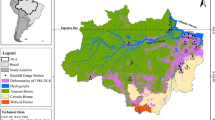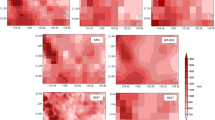Abstract
Several studies have been devoted to dynamic and statistical downscaling for both climate variability and climate change. This paper introduces an application of temporal neural networks for downscaling global climate model output and autocorrelation functions. This method is proposed for downscaling daily precipitation time series for a region in the Amazon Basin. The downscaling models were developed and validated using IPCC AR4 model output and observed daily precipitation. In this paper, five AOGCMs for the twentieth century (20C3M; 1970–1999) and three SRES scenarios (A2, A1B, and B1) were used. The performance in downscaling of the temporal neural network was compared to that of an autocorrelation statistical downscaling model with emphasis on its ability to reproduce the observed climate variability and tendency for the period 1970–1999. The model test results indicate that the neural network model significantly outperforms the statistical models for the downscaling of daily precipitation variability.





Similar content being viewed by others
References
Boulanger JP, Martinez F, Segura EC (2006) Projection of future climate change conditions using IPCC simulations, neural networks and bayesian statistics. Part 1. Temperature mean state and seasonal cycle in South America. Clim Dyn 27:233–259
Boulanger JP, Martinez F, Segura EC (2007) Projection of future climate change conditions using IPCC simulations, neural networks and Bayesian statistics. Part 2: precipitation mean state and seasonal cycle in South America. Clim Dyn 2:255–271
Cavazos T (1999) Large-scale circulation anomalies conducive to extreme precipitation events and derivation of daily rainfall in Northeastern Mexico and Southeastern Texas. J Climate 12:1506–1523
Christensen JH, Carter TR, Rummukainen M, Amanatidis G (2007) Evaluating the performance and utility of regional climate models: the PRUDENCE project. Clim Change 81:1–6. doi:10.1007/s10584-006-9211-6
Dibike YB, Coulibaly P (2006) Temporal neural network for downscaling climate variability and extremes. Neural Network 19:135–144. doi:10.1016/j.neunet.2006.01.003
Gao X, Pal JS, Giorgi F (2006) Projected changes in mean and extreme precipitation over the Mediterranean region from a high resolution double nested RCM simulation. Geophys Res Lett 33:L03706. doi:10.1029/2005GL024954
Giorgi F (1990) Simulation of regional climate using a limited area model in a general circulation model. J Clim 3:941–963
Giorgi F, Bi X, Pal JS (2004) Mean interannual variability and trends in a regional climate change experiment over Europe. Part I: present day climate (1961–1990). Clim Dyn 22:733–756
Hewitson BC, Crane RG (1992) Large-scale atmospheric controls on local precipitation intropical Mexico. Geophys Res Lett 19:1835–1838
Hulme M, Jenkins GJ, Lu X, Turnpenny JR, Mitchell TD, Jones RG, Lowe J, Murphy JM, Hassell D, Boorman P, Macdonald R, Hill S (2002) Climate-change scenarios for the United Kingdom: the UKCIP02 Scientific Report. Tyndall Centre for Climate Change Research. School of Environmental Sciences. University of East Anglia, Norwich, p 120
Kidson JW, Thompson CS (1998) A comparison of statistical and model-based downscaling techniques for estimating local climate variations. J Clim 11:735–753
Marengo J, Ambrizzi T (2006) Use of regional climate models in impacts assessments and adaptations studies from continental to regional and local scales: The CREAS (Regional Climate Change Scenarios for South America) initiative in South America. Proceedings of 8 ICSHMO, Foz do Iguaçu, Brazil, April 24–28, 2006, pp 291–296
Mearns L (2004) NARCCAP North American Regional Climate Change Assessment Program A Multiple AOGCM and RCM Climate Scenario Project over North America. 12/17/2004. AGU Fall Meeting, San Francisco, USA
Meehl G, Covey C, Delworth T, Latif M, McAvaney B, Mitchell J, Stouffer FB, Taylor R (2007) The WCRP CMIP3 Multimodel data set. A new era in climate change research. Bull Am Met Soc. doi:10.1175/BAMS-88-9-1383
Nakicenovic N, Alcamo J, Davis G, de Vries B, Fenhann J, Gaffin S, Gregory K, Grbler A, Jung TY, Kram T, La Rovere EL, Michaelis L, Mori S, Morita T, Pepper W, Pitcher H, Price L, Raihi K, Roehrl A, Rogner H-H, Sankovski A, Schlesinger M, Shukla P, Smith S, Swart R, van Rooijen S, Victor N, Dadi Z (2000) IPCC special report on emissions scenarios. Cambridge University Press, Cambridge, pp 599
Rumelhart DE, Durbin R, Golden R, Chauvin Y (1995) Back-propagation: the basic theory. In: Chauvin Y, Rumelhart DE (eds) Back propagation: theory, architectures, and applications. Lawrence Earlbaum, Hillsdale, pp 1–34
Salathe EP (2003) Comparison of various precipitation downscaling methods for the simulation of streamflow in a Rainshadow River Basin. Int J Climatol 23:887–901
Solman AS, Nuñez MN (1999) Local estimates of global climate changes: a statistical downscaling approach. Int J Climatol 19:835–861
Weichert A, Burger G (1998) Linear versus nonlinear techniques in downscaling. Clim Res 10:83–93
Widmann M, Bretherto CS, Salathe EP (2003) Statistical precipitation downscaling over the Northwestern United States using numerically simulated precipitation as a predictor. J Climate 16:799–816
Zhang X, Zwiers FW, Hegerl GC, Lambert FH, Gillett NP, Solomon S, Stott PA, Nozawa T (2007) Detection of human influence on 20th century precipitation trends. Nature 448:461–466
Acknowledgments
The present work was supported by the FAPESP grant 07/50145-4, and Jose A. Marengo was funded by the Brazilian Conselho Nacional de Desenvolvimento Cientifico e Tecnologico—CNPq. We are also grateful for the helpful comments made by anonymous reviewers.
Author information
Authors and Affiliations
Corresponding author
Rights and permissions
About this article
Cite this article
Mendes, D., Marengo, J.A. Temporal downscaling: a comparison between artificial neural network and autocorrelation techniques over the Amazon Basin in present and future climate change scenarios. Theor Appl Climatol 100, 413–421 (2010). https://doi.org/10.1007/s00704-009-0193-y
Received:
Accepted:
Published:
Issue Date:
DOI: https://doi.org/10.1007/s00704-009-0193-y




